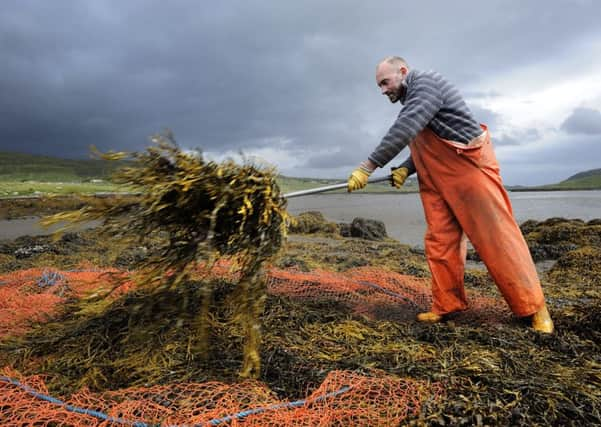Craig Houston: There's green gold on them thar beaches
This article contains affiliate links. We may earn a small commission on items purchased through this article, but that does not affect our editorial judgement.


Make that to go, thanks. No time to hang around, what with an 8am call, then a 10.30 meeting followed by a noon brainstorm, a lunchtime seminar, before a 1.30pm catch-up, 3pm one-to-one, 5.30pm review, 6.30pm networking… and a nervous breakdown.
It’s little wonder we’re a green smoothie generation. The manifestation of a curiously celebrated work-a-holic western culture crossed with a craze for all things energy enhancing, age defying and stress relieving. Our oddly opposed objectives contrive to have us fixated on a daily quest for micronutrient salvation. Supercharged on superfood as society seeks an edible answer to its daily sins, one might say.
Advertisement
Hide AdAdvertisement
Hide Ad

Forget your ‘five-a-day’
As we strain to keep pace with the demands placed on us by modern life, people have moved beyond the famous five-a-day prescription into the realms of “food as fuel” for their super-human daily schedules. A host of humble foodstuffs have thus been glorified and (commercially) christened as the answer to our dietary prayers.
You might, therefore, forgive the healthy dose of scepticism with that smoothie. Indeed, the cult of the green smoothie and superfood superfads are things we’re quite used to by now. It’s safe to say that for a long time we’ve had our own unique interpretation of “superfood” in Scotland – a land where Irn-Bru was once an energy drink and Dairy Milk Fruit & Nut a “healthy” snack.


But we’re slowly catching on to the cool kids. Stornoway black pudding serving as a more modern case in point. That said, Scotland’s most recent and controversial additions to the elite list of superfoods might well still draw a smirk.
Quite the sea treasure
Seaweed has been a slightly less controversial staple on most people’s superfood lists for quite some time now. Fairly new to most western diets, if not eco-systems, it has been championed by producers across Asia as a nutrient dense goldmine containing a wide spectrum of various vitamins, minerals, trace elements and antioxidants. Fresh, dried, cooked or in powdered supplement form, seaweed is versatile as an ingredient and seasoning in a host of oriental cuisine.
From thyroid function, to diabetes and heart health, initial studies have also produced incredibly positive results showing the myriad health benefits seaweed consumption can bring. And far from simply being a conscience boosting smoothie supplement, beauty products are also increasingly reliant on seaweed extract as a core ingredient, with cosmetic industry demand at record levels.
Yon bonnie banks
Seaweed’s crowning as “green gold” is a decidedly far cry from most people’s childhood memories of beach trips tangled in the green stuff. In truth, we have always had a slightly spurious relationship with seaweed, but with a climate particularly conducive to cultivating a certain cold species, Scotland is now determined to join the party. Sounds about right.
Advertisement
Hide AdAdvertisement
Hide AdThe world’s least sexy superfood seems ripe for Scottish influence. Goji Berries… no thanks. Something with “weed” in its name is more Scotland’s style. Indeed, with the launch of seaweed farming trials in Oban very recently, Scotland has its sights set on a seaweed bonanza, and on challenging Asia’s global monopoly in production of everyone’s favourite new slimy green snack.
Ingredients for success?
On a serious note, such lucrative markets are not ones to sneer at, particularly in the current political and economic climate where domestic levels of production are being laid bare under dual Brexit and indyref2 spotlights. Of course, Scotland is no stranger to seaweed harvesting, with companies like Mara Seaweed making inroads into major retail and Michelin-starred kitchens. As other businesses and entrepreneurs now eye up the opportunities Scotland’s coastline presents for farming as well as harvesting, they’re likely to be pondering a number of pertinent questions.
Does Scotland really have the ingredients for a home-grown superfood success? Coastline – tick. Climate – tick (no, really). Aquaculture experience and expertise – tick. Is our legal landscape supportive to growing the industry? Good question.
Out of the weeds
Until recently, coastline and seabed licensing was the preserve of the Crown Estate. Marine Scotland has since taken command, and the prospective seaweed farmers may want to cosy up. Early indications are of a stricter, more involved, licensing process. Thereafter, the pathway to Protected Geographical Indicator of Origin status, reserved for products of certain origin and quality, might well be at the forefront of draft business plans and early trademark applications. Other legal and practical barriers to market await, such as the outcome of the farming trials and safety of workers.
As businesses navigate the opportunities and challenges involved, and the proclivities of a nation simultaneously shift to embrace seaweed as a delicacy, the government’s recently published guidelines for commercial seaweed cultivation have been designed to bring some much needed guidance and clarity to the fledgling industry. Environmental impact, species-type, location and scale feature as the core tenets on which the government hopes to build a sustainable and environmentally friendly and commercially viable industry – with the intricacies of each likely to have legal minds focused for a while to come.
Juiced and ready
Oft mistaken as mysterious, exotic wonder foods from afar, there are more and more superfoods, like seaweed, emerging closer to home. Our seduction by supply chains and supermarket-led eating habits have had a marked impact on provenance in these parts. It serves as a solemn reminder that we have increasingly foregone seasonality and many of our own home-grown culinary treasures, not quite guarded by the generations with the same passion as our Asian cousins.
Advertisement
Hide AdAdvertisement
Hide AdBut as the prospect of Scottish seaweed in our smoothies becomes more realistic (farmed or harvested), it’s a timely reminder that Scotland’s larder is the source of a plethora of “superfoods” that with the correct licensing and legal support, can compete on a global scale.
• Craig Houston is a solicitor at law firm MacRoberts